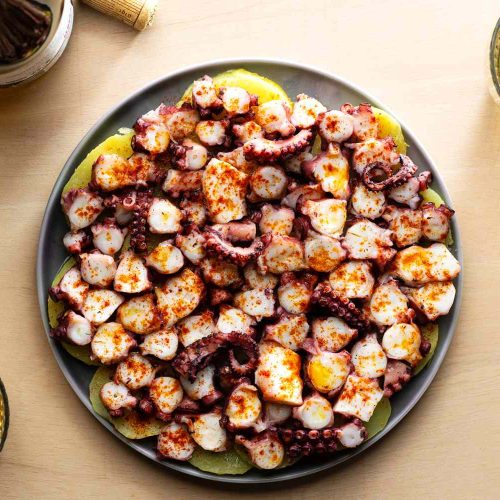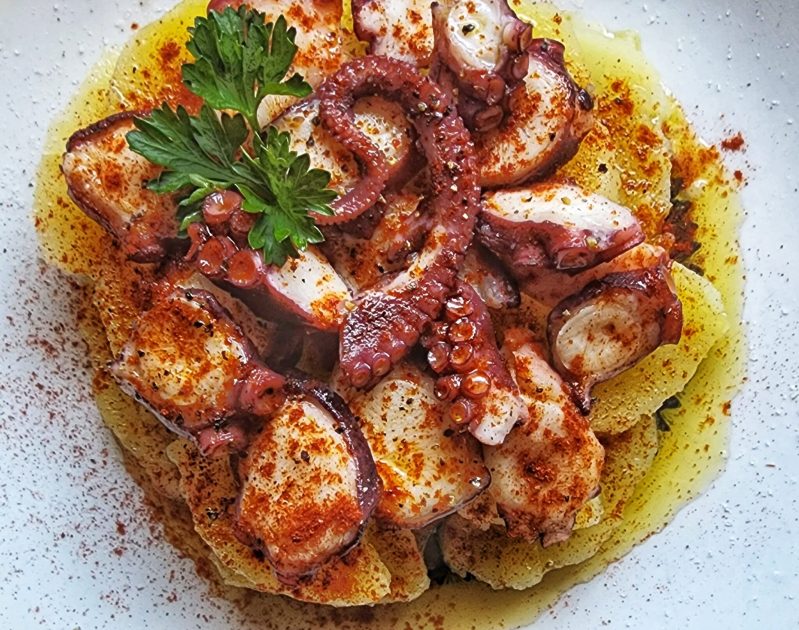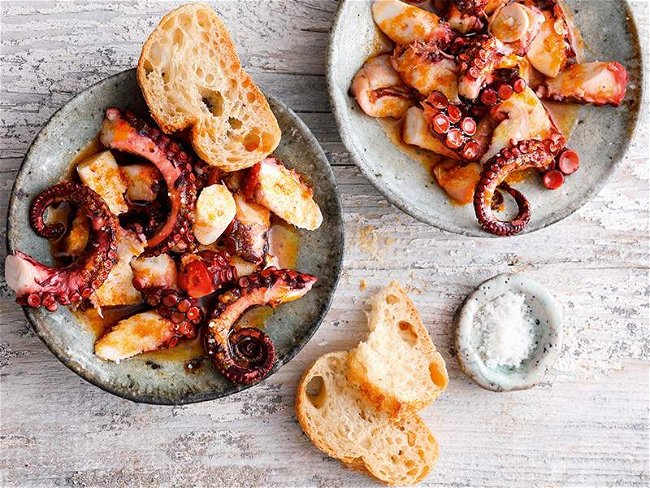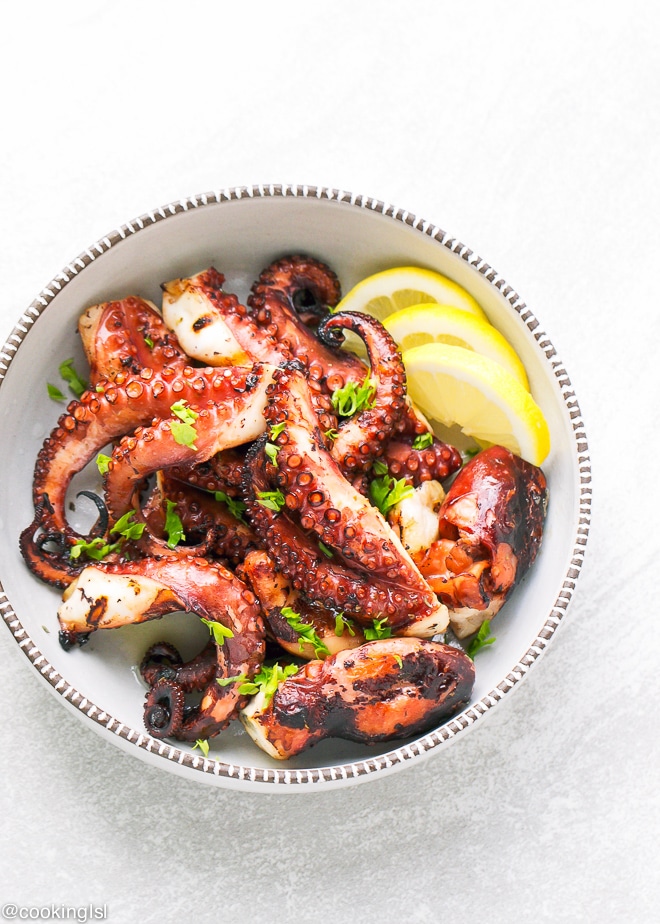On a spontaneous journey through the heart of Galicia, a region famed for its rich culinary traditions and vibrant market squares, I was introduced to a dish that captured the essence of local flavors and communal dining – A Galician-Style Octopus Tapas. This dish, a staple in Galician cuisine, features tender octopus seasoned generously with Spanish smoked paprika, served atop boiled potatoes, creating a harmony of flavors that resonate with the soul of Spain. Savoring each bite amid the laughter and stories shared around the table, I was inspired by the blend of simplicity and depth in this delectable tapas. Determined to recreate this culinary delight back home, I embarked on a journey to perfect the recipe. After several attempts, mastering the technique to achieve the perfect balance of smokiness from the paprika and the succulence of the octopus, I am excited to share this cherished recipe with you. Join me in bringing a piece of Galician conviviality to your table, inviting friends and family to gather and enjoy a taste of Spanish hospitality through this exquisite octopus tapas.

A Galician-Style Octopus Tapas
Equipment
- 1 big pot
Ingredients
- Spanish smoked paprika
- Extra virgin olive oil
- 500 g of potatoes
- Sea salt flakes
- 1 whole octopus
Instructions
- Once the water starts to boil, bring a big pot of water on the stove with a grain of salt.
- On medium-high heat, roast your octopus for 15 to 20 minutes.
- Ensure that the octopus remains submerged in water during the cooking process.
- Octopus, like spaghetti, must be al dente.
- Enable the octopus to rest throughout the liquid ingredients for a few minutes after it has finished cooking.
- Break the octopus tentacles and vegetables into 1⁄2 inch thick slices to eat.
- Table salt, cayenne pepper, and a healthy drizzle of olive oil complete the dish.
Cooking tips about A Galician-Style Octopus Tapas

- Choosing the Right Octopus: The key to an authentic Galician-Style Octopus Tapas lies in selecting a high-quality octopus. Fresh octopus is ideal, but frozen can work just as well if it’s properly thawed. Remember, the octopus will reduce in size significantly after cooking, so consider its initial weight carefully.
- Tenderizing the Octopus: To achieve the perfect tenderness, boil the octopus with a cork in the pot, as traditional Galician chefs suggest. This might sound like an old wives’ tale, but many swear by this method for breaking down the octopus’s muscle fibers, resulting in a more tender texture.
- Cooking Technique: Begin by dunking the octopus in boiling water three times, holding it by the head, then let it cook at a simmer. This shock method helps to curl the tentacles beautifully and ensures the skin doesn’t peel off too much during the cooking process.
- Achieving the Perfect Cut: Once cooked and cooled slightly, cut the octopus into thin slices. The thickness of the slices can vary based on personal preference, but traditionally, they are about ½ inch thick. Use kitchen scissors or a sharp knife for precise cuts.
- Seasoning with Smoked Paprika: The distinctive flavor of this tapas comes largely from the Spanish smoked paprika used for seasoning. After placing the sliced octopus over boiled and sliced potatoes, generously dust it with the paprika, adjusting the quantity to suit your taste. The smokiness of the paprika should complement but not overpower the octopus.
- The Potatoes: Boil potatoes until they are just tender, slice them, and lay them as a base on the serving plate. They should absorb the flavors of the octopus and paprika, acting as a simple yet flavorful foundation for the dish.
- Final Touches: Drizzle a good quality extra virgin olive oil over the plated octopus and potatoes, then sprinkle with coarse sea salt. These finishing touches enhance the flavors and add a luxurious texture to the dish.
- Serving: Serve the tapas warm or at room temperature, allowing the flavors to meld together perfectly. Traditional Galician-Style Octopus Tapas is enjoyed as part of a larger meal or on its own, accompanied by a glass of crisp Albariño wine to complement the dish’s flavors.
Serving suggestions about A Galician-Style Octopus Tapas

- Create a Casual Yet Elegant Display: Serve the octopus tapas on a rustic wooden board or a simple ceramic platter to reflect the dish’s humble origins and its place in modern culinary presentations. The aim is to combine tradition with a touch of elegance, making it inviting for both family and guests.
- Pair with Spanish Wines: Opt for a bottle of crisp Albariño or a light, refreshing Ribeiro wine to complement the dish. These Galician wines, known for their bright acidity and sea breeze qualities, enhance the flavors of the octopus and smoked paprika, tying the meal together beautifully.
- Incorporate Traditional Sides: Accompany your octopus tapas with a selection of Galician sides such as Padrón peppers (lightly fried and sprinkled with sea salt) and a simple salad of tomatoes and onions dressed with olive oil and sherry vinegar. These sides add freshness and balance to the rich flavors of the tapas.
- Bread on the Side: Provide plenty of crusty Galician bread for dipping into the olive oil and sauces. The bread acts as a vessel for savoring every last bit of flavor from the plate.
- Garnish Thoughtfully: A sprinkle of coarse sea salt and a drizzle of high-quality extra virgin olive oil just before serving can elevate the dish significantly. These finishing touches bring out the natural flavors of the octopus and potatoes, adding depth to the dish.
- Ambiance Matters: Set the mood by creating an atmosphere reminiscent of a Galician taverna—think warm lighting, Spanish music softly playing in the background, and perhaps some floral arrangements or candles to add to the ambiance.
- Communal Serving: Encourage sharing by presenting the dish in the center of the table. Tapas are meant to be enjoyed in a communal setting, fostering conversation and a sense of togetherness among diners.
Top 5 FAQs about A Galician-Style Octopus Tapas

- What makes A Galician-Style Octopus Tapas distinct from other octopus dishes? A Galician-Style Octopus Tapas is set apart by its simplicity and the deep flavors it encapsulates. The tender octopus, seasoned with Spanish smoked paprika and served atop perfectly boiled potatoes, encapsulates traditional Galician flavors. Its distinction lies in the method of tenderizing the octopus and the harmonious blend of smokiness from the paprika coupled with the succulent texture of the seafood.
- How do I choose the right octopus for this dish? Selecting a high-quality octopus is crucial for achieving the authentic taste of this tapas. Fresh octopus is ideal, although frozen can also yield excellent results if thoroughly thawed. Consider the size of the octopus since it reduces significantly after cooking; starting with the right weight is essential for ensuring there’s enough to serve.
- Can I make A Galician-Style Octopus Tapas ahead of time? Yes, you can prepare parts of the dish ahead of time. The octopus can be boiled and sliced, and the potatoes cooked until they are tender, then stored in the refrigerator. Before serving, simply reheat gently and assemble with the seasoning and final touches. However, the dish is best enjoyed fresh to maintain the optimal texture and flavors.
- What is the significance of using a cork when boiling the octopus? Boiling the octopus with a cork is a traditional Galician technique believed to tenderize the meat more effectively. While it sounds like a culinary myth, many chefs swear by this method, suggesting it helps break down the muscle fibers resulting in a more tender octopus.
- How should A Galician-Style Octopus Tapas be served? This dish shines when served either warm or at room temperature, allowing the flavors to meld beautifully. Lay the sliced octopus over a bed of boiled potatoes, dust generously with smoked paprika, drizzle with extra virgin olive oil, and sprinkle with coarse sea salt for the finishing touch. It’s ideal as part of a larger meal or on its own, accompanied by a crisp Albariño wine that complements the flavors exquisitely.

Leave a Reply